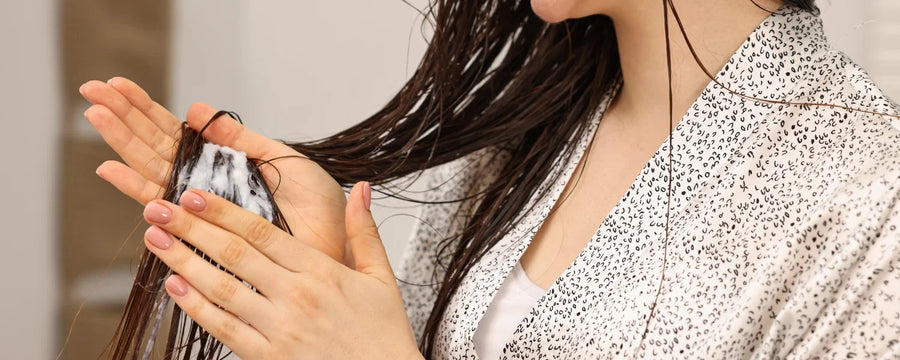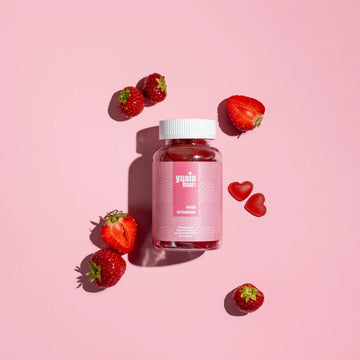
How much conditioner should you use? Based on your hair length and type
by Nitesh Sharma on Apr 30, 2025

Read through by Dorthe Kristensen
Hairdresser and former co-owner of the award-winning hairdressing chain Zoom by Zoom
With many years of experience in the hairdressing industry, Dorthe has advised many customers about hair and hair care. Dorthe has read through this blog entry to ensure high quality and professionalism. This blog post is professionally updated on April 30, 2025.
Table of contents
The question "How much conditioner should I use?" seems simple on the surface but can quickly become complicated once you factor in the variety of hair types, lengths, and individual needs.
Using the right amount of conditioner is important for maintaining healthy, shiny, and manageable hair. This guide will provide a clear framework to help you determine the ideal amount of conditioner based on hair length and type.
Conditioner plays an essential role in any haircare routine. It replenishes moisture stripped away during shampooing, helps smooth the hair cuticle, reduces friction, and protects against breakage. Additionally, it makes detangling easier and prepares hair for styling by enhancing texture and manageability. When used correctly, conditioner promotes a balanced and resilient hair structure.
Determining conditioner quantity based on hair length
Your hair length significantly influences how much conditioner you need. Using the right amount ensures hydration without buildup. While these guidelines are a starting point, adjust based on texture, thickness, and porosity. Observing how your hair responds after conditioning helps tailor the ideal quantity for healthy, manageable hair.
Short hair
For short hair, a dime-sized amount of conditioner is usually sufficient. This amount provides enough coverage without weighing down the hair or overwhelming the scalp. However, if your hair is thick, coarse, or textured, you may need a bit more to achieve proper moisture and manageability.
Rub the conditioner between your palms to warm and distribute it evenly before application. Gently work it in from the ends toward the roots, avoiding direct contact with the scalp if your hair tends to become oily.
For added care—especially if your hair is dry, treated, or colored—a lightweight leave-in conditioner can be applied after rinsing. It helps retain moisture, reduce frizz, and add shine without causing buildup. With the right amount and proper technique, short hair can appear healthier, more manageable, and well-maintained.
Medium-length hair
A quarter-sized amount generally provides enough coverage from mid-lengths to ends for most medium-length hairstyles. This amount ensures a consistent level of moisture and softness across the more exposed sections of the hair. However, if your hair is layered, thick, or prone to tangling, slightly increasing the quantity can help prevent patchy results and improve manageability.
For best results, start by warming the conditioner in your hands before applying. Distribute the product evenly by working it through your hair in sections, paying extra attention to the ends where moisture loss and damage are most common. Sectioning your hair not only ensures thorough application but also minimizes waste and product buildup.
Additionally, combing through the conditioned sections with a wide-tooth comb helps detangle and evenly spread the formula, preparing your hair for easier styling and reduced breakage.
Long hair
For long hair, especially if thick or layered, a palm-sized amount of conditioner is often necessary to ensure even hydration—particularly at the mid-lengths and ends, which are more prone to dryness. Dividing the hair into sections during application helps coat each strand evenly and improves moisture absorption. Gently work the conditioner through the hair and let it sit for a few minutes before rinsing.
For added care, especially on damaged or chemically treated hair, follow with a leave-in conditioner or serum while the hair is still damp. This seals in moisture and offers protection from heat and external factors. Using a wide-tooth comb to detangle at this stage reduces breakage and leaves hair smoother and more manageable.
What factor do you consider most when deciding how much conditioner to use?
Adjusting conditioner use according to hair type
Each hair type requires a slightly different approach to conditioning. Fine hair needs less product to avoid buildup, while coarse or curly types need more hydration. Length also matters—short hair needs less than long. Adjust your routine based on how your hair responds, and stay flexible to environmental changes for best results.
Fine or thin hair
Fine or thin hair is highly sensitive to product weight, so it’s important to use a minimal amount of conditioner—typically less than a dime-sized portion, focusing only on the mid-lengths and ends. Choose lightweight, volumizing conditioners that hydrate without weighing the hair down. For very short hair, a pea-sized amount is often enough. Always rinse thoroughly with lukewarm water to avoid residue, which can flatten the roots and reduce volume. Keeping conditioner away from the scalp helps maintain lift, ensuring a fuller, fresher appearance throughout the day.
Thick or coarse hair
Due to its density and texture, thick hair or coarse hair often demands a more generous amount of conditioner to penetrate and moisturize effectively. Sectioning the hair before application allows for better coverage and ensures each strand receives attention.
If your hair is both thick and long, a palm-sized amount might be necessary. Choose rich, emollient-based conditioners that help smooth and soften the cuticle. Allow the product to sit for a few minutes before rinsing to maximize absorption and leave the hair more pliable and manageable.
Curly hair
Naturally drier by structure, curly hair types benefit immensely from intensive and frequent conditioning. These textures are more susceptible to breakage and frizz, making moisture retention critical. Long curly hair, in particular, may need additional product to ensure full coverage. Opt for ultra-hydrating conditioners with ingredients like shea butter, coconut oil, or aloe vera. Apply generously from root to tip, and use techniques like the "praying hands" method or finger raking to distribute product thoroughly.
In addition to regular conditioning, incorporate weekly deep conditioning treatments and leave-in products to enhance curl definition and maintain elasticity.
How to apply conditioner properly
To get the most out of your conditioner, correct application is key—not just for product performance, but also for maintaining the long-term health and manageability of your hair.
-
Avoid applying conditioner directly to the scalp unless the formula is specifically made for it. Concentrating the product on the mid-lengths and ends not only targets the areas that need moisture most but also prevents the roots from becoming greasy or weighed down.
-
It's a good idea to use a wide-tooth comb or your fingers to gently distribute the conditioner through your hair. This ensures that each strand receives coverage and reduces the risk of breakage and tangles.
-
Allow the conditioner to sit for at least two to five minutes, depending on your hair type and the product instructions. This gives the ingredients time to penetrate the hair shaft and deliver full benefits.
-
For thicker or more textured hair, consider applying the product in sections. This helps with coverage and ensures that every part of your hair is equally nourished and treated.
Recognizing signs of over- or under-conditioning
Observing your hair’s behavior after conditioning can help refine your approach and lead to more consistent, healthy results over time. Knowing the signs of over- or under-conditioning can prevent unnecessary damage, help maintain your desired hair texture, and ensure your routine supports your individual hair goals.
-
Over-conditioning: If your hair feels greasy, limp, or heavy just hours after washing, this could be a sign of over-conditioning. This is especially common when conditioner is applied too close to the scalp or in excessive quantities. Over time, this can lead to buildup on the scalp and hair shaft, making the hair more prone to becoming dull, lifeless, and harder to style. Fine or low-porosity hair types are particularly vulnerable, as they tend to absorb less product and show signs of product overload more easily.
-
Under-conditioning: On the flip side, if your hair appears rough, frizzy, or continues to tangle easily after conditioning, it may not be receiving enough hydration. This often occurs when conditioner is applied too sparingly, not distributed evenly, or rinsed out too quickly. Under-conditioned hair lacks the protective coating that helps smooth the cuticle and lock in moisture. This is particularly problematic for longer hair, which is older and more prone to dryness at the ends.
By learning to recognize these signs early, you can make small but impactful adjustments to your routine—whether that means modifying the quantity, changing where you apply the product, or experimenting with different formulations for better results.
Tailoring conditioner use to hair condition
Beyond length and type, your hair’s condition and treatment history affect your conditioner needs. Hair that’s been regularly heat-styled, chemically processed, or exposed to harsh elements usually needs more care.
If you use hot tools often or color your hair, opt for conditioners with proteins and moisture-rich ingredients to help repair and protect it. Similarly, hair that’s been bleached or chemically treated benefits from deeper hydration and ingredients that guard against further damage.
Environmental stressors like chlorine or pollution can also weaken hair. In those cases, consider a weekly deep conditioning mask and a leave-in product to restore balance.
Taking your hair’s past and present condition into account allows you to adjust your routine for better long-term health and appearance.
Damaged or color-treated hair
These strands often lose moisture easily and need richer conditioners to stay healthy. Choose formulas with proteins like keratin and moisturizers like argan oil or shea butter. To enhance resilience and softness, incorporate a deep conditioning mask once a week. Additionally, applying leave-in treatments or serums that offer UV and heat protection can help maintain moisture balance, prevent further damage, and prolong the vibrancy of color. Regular, targeted care ensures that compromised strands remain strong, smooth, and better protected against everyday styling and environmental stressors.
Healthy hair
If your hair is in good condition—meaning it holds moisture and feels smooth—your goal should be to maintain this. Use a moderate amount of lightweight conditioner with ingredients like aloe vera or jojoba oil. Routine care, including regular trims and the occasional clarifying wash, helps prevent buildup and keeps hair healthy.
Finding the perfect balance for healthier hair
There is no universal answer to how much conditioner one should use, as each individual’s hair characteristics and needs are unique. What works well for one person may not yield the same results for another. However, by taking into account the specific factors of your hair’s length, density, texture, and overall condition, you can create a routine that provides the right level of nourishment without weighing the hair down or leaving it under-moisturized.
Achieving this balance starts with observation. Pay attention to how your hair feels and looks after each wash, and adjust accordingly—whether it’s using a bit more product on your ends, switching to a richer formula during colder months, or introducing a clarifying wash when buildup becomes noticeable.
By refining your conditioner routine over time and mastering application techniques, such as sectioning or using a comb for distribution, you’ll support long-term hair health and styling versatility. When applied with intention and adapted as needed, conditioner becomes more than a product—it becomes an integral tool in maintaining soft, resilient, and consistently beautiful hair.
Get a 10% discount code sent to you
Receive the best tips and tricks for your hair from Lotte and Nanna 🥰
 2-5 day delivery
2-5 day delivery
 25.000+ satisfied customers
25.000+ satisfied customers
 Satisfaction Guarantee
Satisfaction Guarantee








